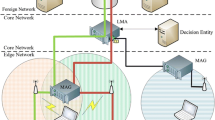Abstract
This paper describes a mechanism and suggests a protocol enhancement to provide global Internet access to Mobile Personal Area Networks and support mobility under different scenarios. For this purpose the concept of the user’s Mobile Station acting as a Mobile Multi-link Subnet Router is introduced, which provides the necessary IPv6 connectivity and mobility service to the nodes connected to the Personal Area Network. The Mobile Station can distinguish between the nodes that need mobility support and the ones that do not in order to provide the appropriate type of IPv6 connectivity service. The main issues discussed are UMTS IPv6 connectivity, routing and mobility for the Mobile Station and the other nodes of the Mobile Personal Area Network.
Chapter PDF
Similar content being viewed by others
Keywords
- Mobile Station
- Home Agent
- Universal Mobile Telecommunication System
- Universal Mobile Telecommunication System
- Mobility Support
These keywords were added by machine and not by the authors. This process is experimental and the keywords may be updated as the learning algorithm improves.
References
Deering, S., Hinden, R.: Internet protocol version 6 (IPv6) specification. RFC 2460 (December 1998)
Loughney, J.: IPv6 node requirements. Internet draft (October 2002) (work in progress)
Thaler, D., Huitema, C.: Multi-link Subnet Support in IPv6. Internet draft (June 2002) (work in progress)
Kniveton, T., Malinen, J., Devarapalli, V., Perkins, C.: Mobile Router Tunneling Protocol. Internet draft (November 2002) (work in progress)
Narten, T., Nordmark, E., Simpson, W.: Neighbor discovery for IPv6. RFC 2461 (December 1998)
Thomson, S., Narten, T.: IPv6 Stateless address autoconfiguration. RFC 2462 (December 1998)
Narten, T., Draves, R.: Privacy extensions for stateless address autoconfiguration in IPv6. RFC 3041 (January 2001)
Johnson D., Perkins C., Arkko J.: Mobility support in IPv6. Internet draft (January 2003) (work in progress)
Universal Mobile Telecommunications System (UMTS); General Packet Radio Service (GPRS) Service description; Stage 2, March 2002. 3GPP TS 23.060 version 5.1.0 for Releases 4, 5, 99 (2002)
Wasserman M.: Recommendations for IPv6 in Third Generation Partnership Project (3GPP) Standards, September 2002. RFC 3314 (2002)
Haskin D., Allen E.: IP Version 6 over PPP, December 1998. RFC 2472 (1988)
Arko J., Devarapalli V., Dupont F.: Using IPsec to Protect Mobile IPv6 Signalling between Mobile Nodes and Home Agents. Internet draft, January 2003. Work in progress (2003)
Universal Mobile Telecommunications System (UMTS); Interworking between the Public Land Mobile Network (PLMN) supporting Packet Based services and Packet Data Networks (PDN), March 2002, 3GPP TS 29.061 version 5.1.0 for releases 99, 4, 5 (2002)
Kent, S., Atkinson, R.: Security Architecture for the Internet Protocol, November 1998. RFC 2401 (1988)
Kent S., Atkinson R.: IP Authentication Header, November 1998. RFC 2402 (1988)
Kent, S., Atkinson, R.: IP Encapsulating Security Payload. RFC 2406 (November 1998)
Droms R., Bound J., Volz B., Lemon T., Perkins C., Carney M.: Dynamic Host Configuration Protocol for IPv6 (DHCPv6). Internet draft, November 2002. Work in progress (2002)
Author information
Authors and Affiliations
Editor information
Editors and Affiliations
Rights and permissions
Copyright information
© 2003 Springer-Verlag Berlin Heidelberg
About this paper
Cite this paper
Alexiou, N., Tsiouris, G., Sykas, E. (2003). Providing Internet Access to IPv6 Mobile Personal Area Networks through UMTS. In: Conti, M., Giordano, S., Gregori, E., Olariu, S. (eds) Personal Wireless Communications. PWC 2003. Lecture Notes in Computer Science, vol 2775. Springer, Berlin, Heidelberg. https://doi.org/10.1007/978-3-540-39867-7_61
Download citation
DOI: https://doi.org/10.1007/978-3-540-39867-7_61
Publisher Name: Springer, Berlin, Heidelberg
Print ISBN: 978-3-540-20123-6
Online ISBN: 978-3-540-39867-7
eBook Packages: Springer Book Archive




